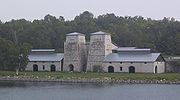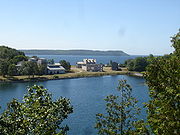
Fayette Historic State Park
Encyclopedia
Fayette Historic State Park is a state park and historic townsite near Fayette in the U.S. state
of Michigan
. Located on the Big Bay de Noc
of Lake Michigan
on the southern side of the Upper Peninsula
, it was the site of an industrial community that manufactured charcoal pig iron
between 1867 and 1891. The town has been reconstructed into a living museum showing what life was like in this town in the late 19th century.
 Fayette was once one of the Upper Peninsula's most productive iron-smelting operations. Fayette grew up around two blast furnaces, a large dock and several charcoal kilns after the Civil War. Nearly 500 residents—many immigrating from Canada, the British Isles, and northern Europe—lived in and near the town that existed to make pig iron. During 24 years of operation Fayette's blast furnaces produced a total of 229,288 tons of iron, using local hardwood forests for fuel and quarrying limestone from the bluffs to purify the iron ore. When the charcoal iron market began to decline, the Jackson Iron Company closed its Fayette smelting operations in 1891. Another event leading to the downfall of the Jackson Iron Company was the use of the hardwoods and limestone to purify the Iron, causing the hardwoods to be destroyed. This was the main source for purifying the iron and therefore led to the decline of the Jackson Iron Company. After shutting down the smelting operations many residents left Fayette in search of something more, and some residents stayed and used the land for farming.
Fayette was once one of the Upper Peninsula's most productive iron-smelting operations. Fayette grew up around two blast furnaces, a large dock and several charcoal kilns after the Civil War. Nearly 500 residents—many immigrating from Canada, the British Isles, and northern Europe—lived in and near the town that existed to make pig iron. During 24 years of operation Fayette's blast furnaces produced a total of 229,288 tons of iron, using local hardwood forests for fuel and quarrying limestone from the bluffs to purify the iron ore. When the charcoal iron market began to decline, the Jackson Iron Company closed its Fayette smelting operations in 1891. Another event leading to the downfall of the Jackson Iron Company was the use of the hardwoods and limestone to purify the Iron, causing the hardwoods to be destroyed. This was the main source for purifying the iron and therefore led to the decline of the Jackson Iron Company. After shutting down the smelting operations many residents left Fayette in search of something more, and some residents stayed and used the land for farming.

The townsite is open daily for visitors from approx. May through October. A visitors center and museum store are also located at the park. There is no admission charge; however, a Michigan State Park permit is required. For more information consult the State of Michigan Fayette page.
There is a beach on Sand Bay (Lake Michigan) just a short distance from the campground. The picnic area is adjacent to the beach and offers a picnic shelter, grills and vault toilets. Playground equipment and horsehoe courts are available.
The historic settlement is listed on the National Register of Historic Places
.
U.S. state
A U.S. state is any one of the 50 federated states of the United States of America that share sovereignty with the federal government. Because of this shared sovereignty, an American is a citizen both of the federal entity and of his or her state of domicile. Four states use the official title of...
of Michigan
Michigan
Michigan is a U.S. state located in the Great Lakes Region of the United States of America. The name Michigan is the French form of the Ojibwa word mishigamaa, meaning "large water" or "large lake"....
. Located on the Big Bay de Noc
Big Bay de Noc
Big Bay de Noc is a bay in the Upper Peninsula of the U.S. state of Michigan. The bay, which opens into Lake Michigan's Green Bay, is enclosed by Delta County...
of Lake Michigan
Lake Michigan
Lake Michigan is one of the five Great Lakes of North America and the only one located entirely within the United States. It is the second largest of the Great Lakes by volume and the third largest by surface area, after Lake Superior and Lake Huron...
on the southern side of the Upper Peninsula
Upper Peninsula of Michigan
The Upper Peninsula of Michigan is the northern of the two major land masses that make up the U.S. state of Michigan. It is commonly referred to as the Upper Peninsula, the U.P., or Upper Michigan. It is also known as the land "above the Bridge" linking the two peninsulas. The peninsula is bounded...
, it was the site of an industrial community that manufactured charcoal pig iron
Pig iron
Pig iron is the intermediate product of smelting iron ore with a high-carbon fuel such as coke, usually with limestone as a flux. Charcoal and anthracite have also been used as fuel...
between 1867 and 1891. The town has been reconstructed into a living museum showing what life was like in this town in the late 19th century.
History


Fayette Historic Townsite
Today, Fayette Historic Townsite is a living museum with many restored buildings. Visitors may walk through the buildings to learn about life in Fayette during the late 19th century. Over 20 buildings are open, with restoration continuing on other parts of the town.The townsite is open daily for visitors from approx. May through October. A visitors center and museum store are also located at the park. There is no admission charge; however, a Michigan State Park permit is required. For more information consult the State of Michigan Fayette page.
Camping
There are 61 semi-modern campsites . Facilities include electrical service to all campsites and access to vault toilets and water. Most campsites are well shaded. Boat camping is allowed in Snail Shell Harbor, and space is on a first-come, first-serve basis.There is a beach on Sand Bay (Lake Michigan) just a short distance from the campground. The picnic area is adjacent to the beach and offers a picnic shelter, grills and vault toilets. Playground equipment and horsehoe courts are available.
Hiking
The park offers approx. 5 miles (8 km) of hiking trails. The trails are groomed in the winter for cross-country skiing. Trails wind through a hardwood forest and throughout the historic townsite.The historic settlement is listed on the National Register of Historic Places
National Register of Historic Places
The National Register of Historic Places is the United States government's official list of districts, sites, buildings, structures, and objects deemed worthy of preservation...
.

